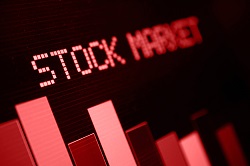So here we are, heading back to 18,000 on the Dow Jones Industrial Average after dipping below the 15,500 mark in August, a 2,500 point move up.
If you've been in the market all along, if you got out during the market sell-off, if you got back in anywhere going back up, or if you've been on the sidelines all this time, there's a good chance you're wondering how to trade the market at these levels.
I'm going to tell you.
That's right. I don't do this often, but today I'm going to show you how I'm going to trade it and why. You can follow along for free.
If I'm wrong, we lose a little money. As a professional trader and hedge fund manager for many, many years, I've put on lots of trades that didn't go my way. We'll plan to get out of the trade with a small loss and get back in the trade again or switch gears and go long.
If I'm right, you'll make a boatload of dough and post a nice comment here.
Here's my thinking...
Cheap Money Brought Markets All the Way Back
 Markets have been riding zero-interest-rate policies and quantitative easing for years and are duly inflated. Everyone knows that.
Markets have been riding zero-interest-rate policies and quantitative easing for years and are duly inflated. Everyone knows that.
What we don't know is how this game is going to end.
We don't know what the "free-market" level of stocks should be because free markets have been hijacked by central banks acting like central planners.
But that hasn't mattered because more and more QE and "stimulus" programs flooded market players with more and more liquidity, meaning more cheap money to play with.
And since economic growth has been a questionable route, most of that money went into short-term positions in financial markets. They're short-term positions not because the investors who've been chasing stocks higher are necessarily short-term traders, they're short-term investments because they can be liquidated on a dime.
We saw what happened back in the summer of 2013 with the "taper tantrum," when then U.S. Federal Reserve Chairman Ben Bernanke hinted the Fed was considering winding down asset purchases.
All hell broke loose and markets tumbled.
Lots of stuff happened between then and this past summer, but not a lot of it mattered. Markets kept being fed their baby formula and kept getting fatter.
That is, until this past August...
Stocks fell globally, and very quickly, because the Fed was talking about raising rates and all of a sudden China decided it would devalue its currency.
That caused a major panic on account of a rising dollar (if the Fed raises rates, the dollar should appreciate) in the face of a falling Chinese yuan would mean other emerging markets countries, to compete for exports with China, would have to depreciate their currencies or the markets would do it for them. The panic concerned how, with depreciating currencies, foreign borrowers would pay back U.S. dollar-denominated loans to the tune of almost $9 trillion.
Oops. The Chinese backed down instantly, the Fed backed down instantly, the ECB suggested more QE to come, the Bank of Japan choked, China had to lower interest rates and reserve ratios again.
It was a mess.
Here's What's Pushing Markets Higher Now
That is until investors said, wait a minute, we know how to dance to this tune. And here we are back up where we left off in August.
But I'm not buying it.
Yes, I know I'm going against the tape (and I rarely do that), and I'm going against the Fed (they may not raise rates in December, next year, or ever, just kidding), and investors are all giddy about the big bounce, and we're coming into the end of the year when money managers desperately try to take the averages up to make their awful years look better. I know all that.
But what if the Fed does raise rates?
What if all the profits that have been made look like they're going to evaporate?
Markets could fall, and quickly.
Yes, we're back up here at 18,000, but that's the headline story.
Here's the truth: The major indexes are being driven by a handful of "hot" stocks.
Those big percentage gainers - Amazon.com Inc. (Nasdaq: AMZN), Facebook Inc. (Nasdaq: FB), Microsoft Corp. (Nasdaq: MSFT), Alphabet Inc. (Nasdaq: GOOG, GOOGL) - are giant companies whose mathematical impact on capitalization-weighted indexes belies what's going on under the surface.
But where's the "breadth?"
Fifty-two percent of stocks that make up the S&P 500 are trading below their 200-day moving averages.
Big stocks, as measured by the S&P 500 (keeping in mind their narrow leadership mentioned above), are up 13% from their August lows. But the Russell 2000 Small-Cap Index is up a mere 5%.
In the bounce after the 2011 dip, more than 90% of stocks traded quickly above their 50-day moving averages. This rally's only pushed 79% above their 50-day moving averages.
A lot of the "buying" looks to me like high-frequency traders taking out small offers on successively higher prices as fast as they can, to push socks up in gap fashion.
Commodities have to hold up, too. Oil (WTI) has to stay above $45 and get above $50.
Copper has to stay above $2.30/lb and not break below $2.20/lb.
And that still-giant elephant in the room, China, has to firm up. The Shanghai Composite took a few hits again recently. If it heads back towards 3,000, or heaven forbid, breaks 3,000, rallies everywhere will reverse, and we'll be back in correction mode in no time.
We're on a knife-edge, and any number of these "negatives" could scare markets.
That's why at 18,000 I'm willing to put on a downside position that will make a lot of money if we can't hold 18,000 and slip backwards.
Here's what to do...
Take a Small Risk at a Major Pivot Point
Because 18,000 is a pivot point, meaning a point that we were at before, a psychological point, a point where investors have to decide to get back in, get more in, or take profits, it's a pivot point, a fulcrum point, a point where we can go either way.
I like taking a small risk at pivot points. I look at the big picture and I get all the headline bluster, but I also see that not everything is on solid ground.
That's why I'm buying the ProShares Short QQQ ETF (NYSE Arca: PSQ).
If the Nasdaq Composite, which is what the QQQ ETF follows, goes down (and I'm choosing the Nasdaq because it has performed the best lately and if stocks turn tail, investors here have the most to lose), then PSQ, which is an inverse ETF (meaning it goes up if the Nasdaq goes down), will rise in price.
So here's what we'll do...
[mmpazkzone name="in-story" network="9794" site="307044" id="137008" type="4"]
Buy PSQ at $51.75 or lower.
If I'm wrong and stocks rally, I'd sell PSQ at $49.16 for only a 5% loss.
If I'm right, I expect to make maybe 20% on the trade.
Risking 5% to make 20% is a worthwhile risk/reward play for me.
And if I'm right and I see markets sell off, this will only be one trade I'll have on. I'll put a lot more leveraged trades on if we start heading down from here.
Follow us on Twitter @moneymorning.
Be Ready to Run: Since the August market sell-off, stocks have been rallying. But if these key commodities tank, expect stock prices to follow. It's all about what's happening behind the scenes - and you need to be watching these two commodities very carefully...
About the Author
Shah Gilani boasts a financial pedigree unlike any other. He ran his first hedge fund in 1982 from his seat on the floor of the Chicago Board of Options Exchange. When options on the Standard & Poor's 100 began trading on March 11, 1983, Shah worked in "the pit" as a market maker.
The work he did laid the foundation for what would later become the VIX - to this day one of the most widely used indicators worldwide. After leaving Chicago to run the futures and options division of the British banking giant Lloyd's TSB, Shah moved up to Roosevelt & Cross Inc., an old-line New York boutique firm. There he originated and ran a packaged fixed-income trading desk, and established that company's "listed" and OTC trading desks.
Shah founded a second hedge fund in 1999, which he ran until 2003.
Shah's vast network of contacts includes the biggest players on Wall Street and in international finance. These contacts give him the real story - when others only get what the investment banks want them to see.
Today, as editor of Hyperdrive Portfolio, Shah presents his legion of subscribers with massive profit opportunities that result from paradigm shifts in the way we work, play, and live.
Shah is a frequent guest on CNBC, Forbes, and MarketWatch, and you can catch him every week on Fox Business's Varney & Co.



